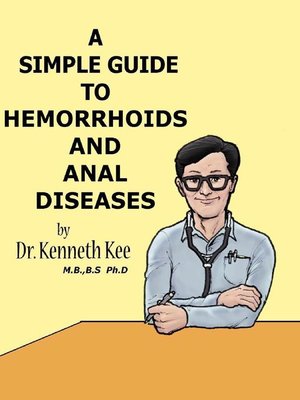A Simple Guide to Hemorrhoids and Anal Diseases
ebook ∣ A Simple Guide to Medical Conditions, no. 10 · Simple Guide to Medical Conditions
By Kenneth Kee

Sign up to save your library
With an OverDrive account, you can save your favorite libraries for at-a-glance information about availability. Find out more about OverDrive accounts.
Find this title in Libby, the library reading app by OverDrive.



Search for a digital library with this title
Title found at these libraries:
| Library Name | Distance |
|---|---|
| Loading... |
Hemorrhoids or piles are distended veins inside the anus which are swollen and inflamed.Hemorrhoids are either inside the anus (internal) or under the skin around the anus (external).What is the cause of hemorrhoids?Hemorrhoids usually result from straining to pass the stool out of anus.Other contributing factors include pregnancy, aging, chronic constipation or diarrhea.What are the symptoms of hemorrhoids?The most common symptom of internal hemorrhoids is1, bleeding from the anus.Bright red blood may be seen covering the stool, on toilet paper, or dripping from the anus into the toilet bowl.2. There may be pain too especially if the stool is hard.This could be due to the hard stools pressing on the swollen piles or due to a tear in the inner lining of the anus.3. A painful swelling or a hard lump around the anus may occur when a blood clot forms.This condition is known as a thrombosed hemorrhoid.4. In addition, excessive straining, rubbing, or cleaning around the anus may cause irritationwith bleeding and/or itching.How common are hemorrhoids?Hemorrhoids are very common in both men and women.About half of the population have hemorrhoids by age 50.Hemorrhoids are also common among pregnant women.The pressure of the fetus in the abdomen, as well as hormonal changes, causes thehemorrhoid vessels to enlarge.For most women, however, hemorrhoids caused by pregnancy are temporary.How are hemorrhoids diagnosed?1. A thorough examination and proper diagnosis by the doctor is important any timebleeding from the rectum or blood in the stool occurs.Bleeding may also be a symptom of other digestive diseases, including colorectal cancer.The doctor will examine the anus and rectum to look for swollen blood vessels that indicatehemorrhoids and will also perform a digital rectal exam with a gloved, lubricated finger tofeel for abnormalities.Closer evaluation of the rectum for hemorrhoids requires an exam with a proctoscope,useful for more completely examining the entire rectum.2. To rule out other causes of gastrointestinal bleeding, the doctor may examine therectum and the entire colon with colonoscopy.Colonoscopy is a diagnostic procedure that also involves the use of lighted, flexible tubeinserted through the rectum.What is the treatment of hemorrhoids?a. Medical treatment of hemorrhoids is aimed initially at relieving symptoms.Measures to reduce symptoms include:1. Tub baths several times a day in plain, warm water for about 10 minutes2. application of a hemorroidal cream or suppository to the affected area.3. medicines such as daflon to shrink the swollen blood vessel.b. surgical treatment:A number of methods may be used to remove or reduce the size of internal hemorrhoids.These techniques include1. Rubber band ligation. A rubber band is placed around the base of the hemorrhoidinside the rectum.The band cuts off circulation, and the hemorrhoid withers away within a few days.2. Sclerotherapy. A chemical solution is injected around the blood vessel to shrinkthe hemorrhoid.3. Laser coagulation. A special device is used to burn hemorrhoidal tissue.4. Hemorrhoidectomy. Occasionally, extensive or severe internal or external hemorrhoidsmay require removal by surgery known as hemorrhoidectomy.5. A new method is the Longo technique.It involves using a circular stapling device which removes a ring of tissue in the loweranus pulling the enlarged piles up within the anus.The staples also interrupt the blood supply to the pilesTABLE OF CONTENTChapter 1HemorrhoidsChapter 2Anal FistulaChapter 3Anorectal Abscess and Anal FissureChapter 4Constipation







